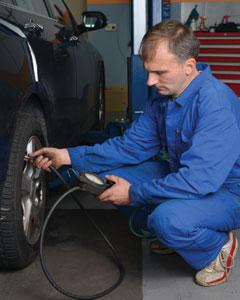
|
| Photo credit: ©istockphoto.com/irman |
I stopped at the gas station the other day because one of my car’s tires looked a bit low. They charge us for air here on the Isle of Long. When I was a young man, it was free. They also used to check the oil and wash the windshield for free but times change. I had my two quarters ready to drop into the machine but then I noticed that the price had gone up to a dollar. So I figured I’d ask the man in the bulletproof-glass booth why the price was now double what it had been on my last visit.
“What’s the deal with the air compressor?” I said. “Why did the price double?”
He smiled, pressed the speaker button and said, “Inflation.”
“Oh.”
OK, that one was right over the plate and I can’t blame the guy for swinging at it so I just smacked my forehead and asked him for change. I walked back to my car and dropped four quarters into the machine. I worked quickly because I think they do time/motion studies with these things and set the timer so you can get only 3 1/2 tires done for a buck. Then it shuts off. I didn’t bother asking the guy in the booth about that.
But I have to admit that I do like putting air in tires. It gives me a chance to bend and stretch and I especially like the sound the compressor makes as it moves the air into the tire. There’s something about the caCHUNK sound that makes me feel as if I’m accomplishing something.
I set the compressor to 32 psi and addressed the tire that had seemed the lowest to me first. The compressor made a bunch of very quick caCHUNK caCHUNK sounds, but then, as the tire filled, I noticed the space between the “ca” and the “CHUNK” began to lengthen. Finally, it just went “ca” as the tire reached 32 psi. I removed the hose and the compressor then went “CHUNK.” That bothered me because I had paid for that last CHUNK and it went into the atmosphere instead of into my tire, but I didn’t bother mentioning it to the guy in the booth.
As I drove away, I started to think about the relationship between the compressor and my tires. How did the compressor know when to stop? It hadn’t run out of money yet. And there was no wiring between the compressor and the tire to signal completion.
And then it dawned on me the compressor stopped because I had it set to deliver just 32 psi to the tire and the tire now contained exactly that much air pressure. So there was no longer any difference in pressure between the compressor and the tire. Without a difference in pressure, there can be no flow. Eureka!
Don’t you think air is glorious? Most people don’t give it much thought unless they’re choking or their house is blowing down, but as I write to you, I’m very aware that 26,460 lb. of air is sitting right on top of this desk. That’s about what a blue whale weighs. But most folks don’t think of such things.
When I was leaving the gas station, I turned on my car radio and the weatherman told me there was a low-pressure area forming and it was going to get very windy later that night. This made me think about hydronic heating systems (most things do). I know high pressure goes to low pressure. Always. And when the weatherman tells me there’s a low-pressure area close to a high-pressure area, I know the air is going to move, just as the compressor fills the tire. We call that wind. The closer the different areas are to each other, the harder the wind is going to blow.
The same happens in any hydronic system (we hope) but instead of calling the movement wind, we call it “flow.” And since heat travels on flow like a passenger on a train, where there is no flow, there is no heat. And it’s going to look just like an air problem. Which it’s not.
A flow-balance problem
Back in the days when air was free and they cleaned your windshield, I sat on the top floor of a building with a contractor friend. We were both bleeding a radiator that didn’t want to get hot. We bled and bled, never getting any air from that radiator, which just made us bleed more. We did this because we were young and dumb. The only thing coming out of that radiator was water, which eventually got hot but we called it bleeding. Dumb.
And when the radiator did get hot, we smiled at each other, got up and left the house. A few hours later, the customer called the contractor to say the radiator was once again cold. So he went back and did it again. The next day she called again.
What’s the definition of insanity?
It took a while, but I finally got it through my thick skull that, when bleeding a radiator, if you don’t get any air, it ain’t an air problem. It’s a flow-balance problem. But it looks just like an air problem. Except there’s no air.
Get it?
Which brings me to circulators. The next time you’re looking at one, notice the arrow that’s cast into its volute. That’s the only arrow in the whole system you can trust. When water leaves the circulator, it’s going to be heading in that direction. Guaranteed. XAnd right there at the discharge of that circulator you will find the highest pressure it can create. Move over to the other flange, the one on the return side, and you will find the lowest pressure that circulator can produce.
Which means every circulator is just like a weather report. High pressure goes to low pressure. Always.
The circulator starts and water goes chugging around the system because of the difference in pressure from one side of the circulator to the other. All the water moves at the same time because this is a closed system and moving one drop of water in a closed system is like moving one link on a bicycle chain. All the links, and all the drops of water, move at the same time.
So the water heads out into the system and as it flows, it loses some of its energy to friction. This happens because the water is rubbing against the insides of the pipe. When water enters an elbow, there’s even more friction because the sudden turn causes turbulence. More of the water touches more of the pipe. On it goes and at some point the water is probably going to enter a tee. Now the water has a choice. Should it go this way or that way?
For the water, the choice is easy; it’s going to flow wherever the difference in pressure is greatest. Just like at the gas station. Just like with the weather report. High pressure goes to low pressure. Always.
The further out into the system the water goes, the more friction it finds and the closer the pressure differential becomes. Remember how the air compressor went caCHUNK really quickly and then slowed to “ca” and, after a pause, “CHUNK” as the pressure in the tire approached the set pressure of the compressor? Well, in a hydronic system the same thing goes on way out there in the building or up near those top-floor radiators. There’s less differential pressure between any two points and that means the flow is going to slow down.
And since heat travels on flow like a passenger on a train, we sit on the top floor bleeding phantom air from radiators that contain no air. We think we’re bleeding but we’re actually draining. And draining creates flow. Which is why the radiator gets hot.
If you have time to sit there for the rest of the winter, it will stay hot.
But you probably can’t do that.
So the next time you get frustrated, think about inflation. Think about the weatherman. And please think about this story. Just because I had to learn this lesson the hard way doesn’t mean you have to do the same.



